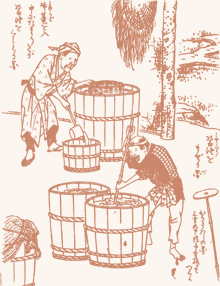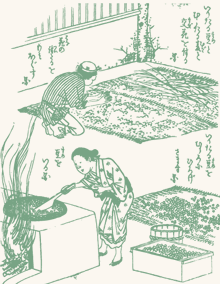
THE ROOTS OF SOY SAUCE ARE IN CHINA
It’s said that the roots of soy sauce can be traced back to a sauce called “jan” in ancient China. That began from pickling raw materials in salt to preserve them, and there were varieties based on fruit, vegetables, and seaweed etc., on meat and fish, on meat only, and on grains. The grain type, using rice, wheat, and soybeans, is thought to be the archetype of soy sauce. It is not clear when it came to Japan, under the name “hishio”, but according to the Taiho Code, “hishio” made from soybeans was to be made at the hishio institute belonging to the cuisine division of the Imperial Household Agency. In modern terms, that hishio was midway between soy sauce and miso paste, and appears to have reached the dining tables of palace banquets. After that, the making of miso paste was begun using the Kinzanji method that the Zen monk Kakushin brought back from China in 1254 (in the Kamakura era). It is said that while he was teaching that miso-making method to the villagers of Kishu Yuasa, he noticed that the liquid that seeps out of hishio tasted really good, and that became what is now known as “tamari soy sauce”.
JAPANESE SOY SAUCE WAS BORN IN THE KANSAI REGION

The soy sauce manufacturing methods that is said to have been born in Kishu Yuasa kept on advancing after that. Around 1580 (Tensho era) , Tamai soy sauce, thought to be the first soy sauce vendor in Japan, started selling soy sauce and miso paste. There is a record from 1588 (Tensho year 16) of approximately 18,000L of tamari soy sauce being sent from Kishu to Osaka. This suggests that soy sauce was already a daily necessity among the townspeople of Osaka. In Kanto, on the other hand, soy sauce had arrived but was not being manufactured. It was being brought from Kansai. It was called “Kudari” soy sauce, which means it had been brought from the capital.
THE ARRIVAL OF COMMON SOY SAUCE, TO THE TASTE OF EDOITES

With the start of the Edo period and the reigns from Genroku to Kyoho (1688-1736), the population of Edo was growing. The production of strongly flavored soy sauce, to the taste of Edo citizens, began. The kudari soy sauce from Kansai was countered by “jimawari” (local) soy sauce, which was the equivalent of modern common soy sauce. The booming centers of soy sauce making from that time were the cities of Noda and Choshi in Chiba prefecture. They are situated on the broad flat land of the Kanto plain, where soy beans and wheat are grown, and had the advantage of waterways such as the Tone and Edo rivers, so they became the centers of soy sauce production in Kanto. They are still the biggest production regions for common soy sauce.
SOY SAUCE FROM JAPAN TO THE WORLD

The internationalization of Japanese soy sauce actually began in the Edo era. Japan was then in its period of national isolation, but trade was permitted between Nagasaki and Holland as the only exception. The Dutch ships and Chinese ships started carrying Japanese soy sauce to the Chinese mainland, other parts of Southeast Asia, and as far as Holland. The soy sauce exported in that period was local soy sauce produced in Sakai in Osaka, in Kyoto, and in Kyushu. Other than shipping in barrels, it appears to have been sent in earthenware bottles called “konpura bottles”. After that, soy sauce was loved around the world as a versatile condiment. It’s popularity joined with the current boom in Japanese food to put soy sauce on meal tables around the world.